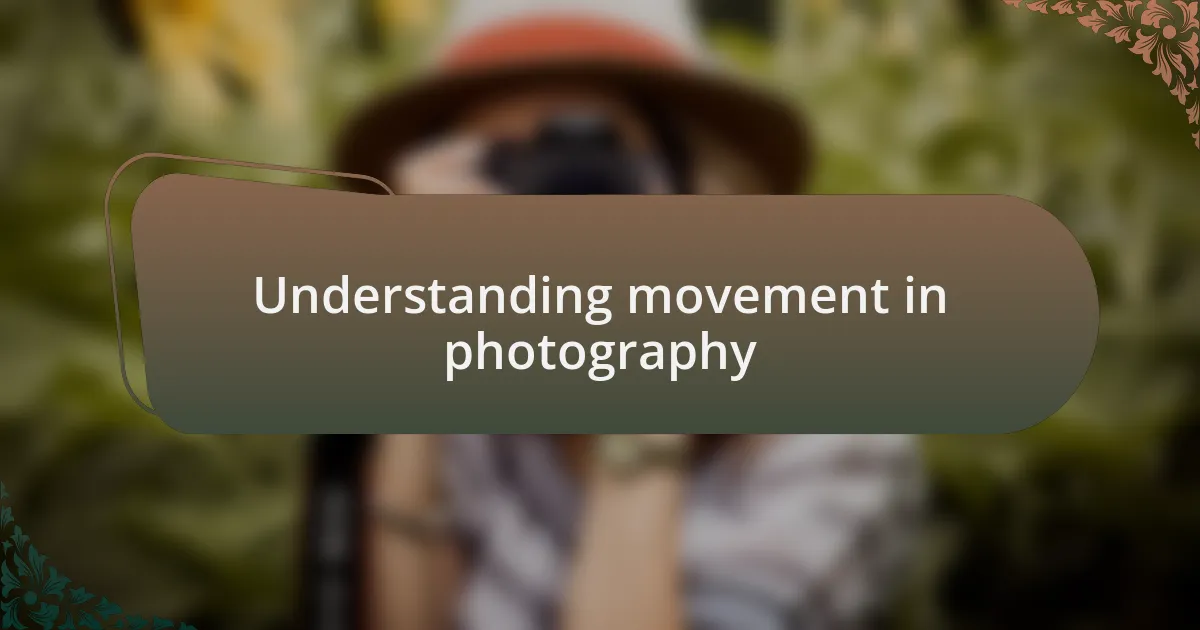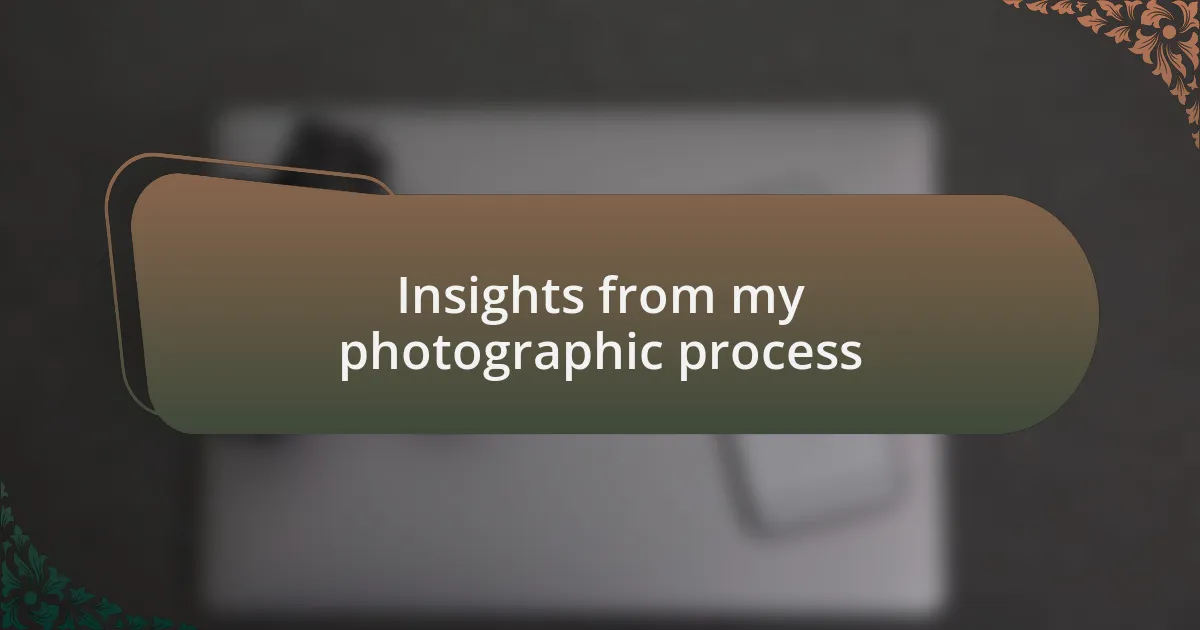Key takeaways:
- Movement in photography adds dynamic layers to images, conveying stories that stillness alone cannot express.
- Techniques like panning and high-speed photography enhance the representation of motion, while double exposures can create multi-layered narratives.
- Contrasts in photography—between movement and stillness, and light and shadow—can evoke deep emotional responses and reveal hidden stories.
- Personal experiences and reflections during photography sessions emphasize the importance of capturing both motion and stillness to convey meaningful narratives.

Understanding movement in photography
Understanding movement in photography can be a profound journey. When I first picked up a camera, I remember being fascinated by how motion could be captured in a single frame. Have you ever paused to think about how movement adds a dynamic layer to an otherwise static image?
For instance, consider the rush of a busy street scene. The blur of pedestrians or the streaking lights of passing cars create a narrative that stillness alone cannot convey. In my experience, those blurred lines can evoke feelings of excitement or urgency, inviting the viewer to imagine the life unfolding beyond the frame. It challenges us to see beyond mere composition and inquire: what story is being told through this movement?
I often find that incorporating movement, whether through intentional blur or the focus on a moving subject, can transform an image from ordinary to extraordinary. Think about your own photographs—are you capturing the essence of motion, or are you merely freezing time? This exploration into how movement interacts with stillness can profoundly enhance our storytelling through photography.

Techniques for capturing movement
Capturing movement in photography often involves a delicate balance of technique and intuition. One method I frequently use is panning, where I follow a moving subject with my camera while using a slower shutter speed. The result? A sharp subject against a beautifully blurred background, evoking a sense of speed and action. I remember the first time I successfully panned a cyclist zooming past; the thrill of capturing that moment left me eager to experiment further.
Another technique that I’ve found effective is using a fast shutter speed to freeze motion. I once had the chance to photograph a skateboarder in mid-air. The split-second decision to increase my shutter speed allowed me to capture the intricate details of the skateboarder’s expression and the dynamics of their pose. Have you ever noticed how stopping motion can reveal hidden aspects of a scene that might otherwise go unnoticed? It’s exciting to think how each click can unveil a new layer of a story.
Of course, high-speed photography isn’t the only way to convey movement; sometimes the essence lies in the subtleties. For instance, I often experiment with double exposures to superimpose two moments of action into one frame. The interplay between these images can create a striking visual narrative. This technique invites the viewer to consider the relationship between moments and movements—are they continuous, or do they create a tension that compels further exploration?

Exploring contrasts in photography
Exploring contrasts in photography can breathe life into a composition, particularly when juxtaposing movement against stillness. I recall a rainy cityscape where I captured a stationary statue with umbrellas moving in the foreground. The contrast between the unmoving figure and the bustling life around it created a powerful narrative about solitude amid chaos. It made me reflect: how often do we stop to appreciate the stillness in our lives?
When I experiment with light and shadow, I find that contrasts evoke emotion as well. I had the opportunity to photograph dancers performing in a dimly lit theater. The sharp, bright light revealing their movements against the shadows highlighted their fluidity and grace—and, at that moment, sparked a dialogue within me about the balance of light and dark in our own journeys. Can you think of moments in your life where light pierced through the darkness, revealing something profound?
Contrasts can also manifest through color and texture; they add layers of depth to an image. One of my favorite shots was a close-up of a weathered tree trunk with vibrant flowers dotting its surface. The roughness of the bark juxtaposed with the soft petals conveyed resilience and beauty. It reminded me that there’s often strength found in vulnerability. Have you ever captured an image that told a story beyond words through the contrasts within it?

Personal journey in photography
Photography has always been a profound journey for me, where each click of the shutter serves as a reflection on my own experiences. I remember a quiet afternoon spent in a local park, where I stumbled upon an elderly man sitting on a bench, absorbed in a book. Capturing that moment felt like freezing a piece of time, emphasizing not just his stillness but also the world bustling around him—kids playing, joggers passing by. It struck me how we often overlook the stories simmering in serene moments.
In my exploration of stillness, I’ve also found solace in nature. There was a day when I ventured into a foggy forest, where the air was thick with mystery. As I framed a solitary tree shrouded in mist, I felt an overwhelming peace wash over me. It was as if time stood still. This experience made me question: how often do we pause to breathe and truly absorb our surroundings? Each shot I took sent ripples of tranquility through me, reinforcing my belief that stillness can speak volumes.
One of my favorite sessions involved capturing the stillness of a frozen lake at dawn. As the first light broke over the horizon, the surface shimmered like glass, untouched by movement. It reminded me of those moments in life where we feel suspended between past experiences and future possibilities. Was this a reflection of my own journey? I realized that within stillness lies an opportunity for contemplation, urging me to delve deeper into both my craft and my personal growth.

My favorite movement captures
Capturing movement in stillness often leads me to unexpected moments of beauty. One particularly memorable shot was taken during a bustling street festival. I noticed a young dancer, lost in the rhythm of the music, her arms outstretched as if embracing the very essence of joy. While everyone around her hurried from stall to stall, her unwavering focus transformed the chaos into a serene spectacle that demanded attention. That image, filled with movement yet rooted in her stillness, is one of my all-time favorites.
Another favorite moment occurred while photographing a waterfall. I positioned myself at a vantage point that allowed me to frame the flowing water against the rugged stones. The contrast mesmerized me; the water cascaded energetically yet seemed to hold a stillness in its path. I couldn’t help but wonder: how does something so dynamic coexist with such tranquility? That shot captures the essence of nature’s commitment to balance, an enduring reminder that movement and stillness are often two sides of the same coin.
On a recent trip to the coast, I found myself entranced by a flock of birds soaring above the waves. While they danced gracefully in the sky, my lens caught a fleeting moment where one bird momentarily hung in the air, wings spread wide. That stillness amidst the energetic chaos evoked a sense of freedom that was simply unbeatable. Capturing this juxtaposition made me reflect on how fleeting and precious such moments are, compelling us to pause and merge our gaze with the world around us.

Insights from my photographic process
Each time I approach a scene, I am always searching for that subtle interplay between motion and inertia. I recall a serene morning when I ventured out to photograph a misty lake at dawn. As the early rays of sunlight pierced through the fog, I noticed a single kayak gliding across the water, almost ghost-like in its movement. The kayak’s gentle ripples contrasted with the stillness of the surrounding landscape, prompting me to ask: how can such fluid motion evoke profound calm?
One time, while observing a group of children playing in a park, I realized how movement in their laughter created an invisible thread connecting each fleeting moment. Their joyous energy seemed to ripple through the air, yet my camera caught one child standing still, watching the others play with pure delight. This contrast made me ponder: isn’t it fascinating how stillness can be as expressive as movement? It’s a reminder that sometimes, it’s the quiet spaces in between that tell the most compelling stories.
In another encounter, I found myself in an art gallery, closely observing people engaging with the exhibits. I focused on a woman who was standing still, completely absorbed in a painting, her face reflecting a myriad of emotions. While the world around her buzzed with energy, her moment of contemplation felt like a poignant reflection of movement within stillness. It left me wondering how often we overlook these introspective experiences – could it be that the most impactful movements happen within our minds? This is the essence of what I strive to capture in my photography.